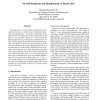Free Online Productivity Tools
i2Speak
i2Symbol
i2OCR
iTex2Img
iWeb2Print
iWeb2Shot
i2Type
iPdf2Split
iPdf2Merge
i2Bopomofo
i2Arabic
i2Style
i2Image
i2PDF
iLatex2Rtf
Sci2ools
IPPS
2003
IEEE
2003
IEEE
On Self-Similarity and Hamiltonicity of Dual-Cubes
The dual-cube is a newly proposed topology for interconnection networks, which uses low dimensional hypercubes as building blocks. The primary advantages of the dual-cube over the hypercube are that, with the same node degree n, the dual-cube contains 2n;1 times more nodes than the hypercube and, with the same amount of nodes, the dual-cube has approximately 50% less links than the hypercube. This paper was focused on the investigations of the structural self-similarity and the Hamiltonian property of the dual-cube. It was shown that a dual-cube can be recursively constructed from lower dimensional dual-cubes and, conversely, a dual-cube can be recursively decomposed into lower dimensional dual-cubes. It was also proved that all dual-cubes are Hamiltonian. There exist multiple Hamiltonian cycles on a dual-cube, among which, b(n ;1)=2c cycles are edge-disjoint. It was illustrated that rings and linear arrays can be effectively emulated on dual-cubes. Some strategies for track sharing i...
Distributed And Parallel Computing | IPPS 2003 | Low Dimensional Hypercubes | Lower Dimensional Dual-cubes | Multiple Hamiltonian Cycles |
| Added | 04 Jul 2010 |
| Updated | 04 Jul 2010 |
| Type | Conference |
| Year | 2003 |
| Where | IPPS |
| Authors | Changfu Wu, Jie Wu |
Comments (0)

